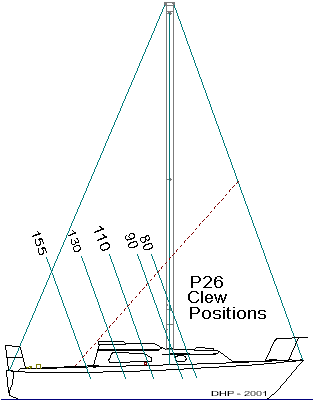 This drawing shows the clew positions for different sail sizes. For a given sail size (in %J) the clew can be anywhere along the indicated line. The area of the sail is constant for a given luff dimension. As the clew is raised the center of area and center of effort are also rasied and the sheeting point moves aft. As the sheeting point moves aft the sheeting angle (angle beteen centerline and line from stem to sheeting point) is reduced. The sheeting angle on the toe rail is about 12 degrees at a point even with the aft end of the cabin house. Smaller sheeting angles allow the boat to point higher into the wind. To get a smaller sheeting angle you can move the sheeting point inboard or move it aft. Raising the clew of a sail will move the sheeting point aft.
This drawing shows the clew positions for different sail sizes. For a given sail size (in %J) the clew can be anywhere along the indicated line. The area of the sail is constant for a given luff dimension. As the clew is raised the center of area and center of effort are also rasied and the sheeting point moves aft. As the sheeting point moves aft the sheeting angle (angle beteen centerline and line from stem to sheeting point) is reduced. The sheeting angle on the toe rail is about 12 degrees at a point even with the aft end of the cabin house. Smaller sheeting angles allow the boat to point higher into the wind. To get a smaller sheeting angle you can move the sheeting point inboard or move it aft. Raising the clew of a sail will move the sheeting point aft.
You can engineer all of the sails to sheet to the same point on the rail by adjusting the clew height. The smaller the sail the higher the clew needs to be to sheet to the same position. All sails with a luff midpoint at the middle of the headstay will sheet to a point on the rail with an angle of about 11 degrees if the clew is on the dashed red line. Raise the clew or lower the midpoint of the luff and the sheeting point moves aft. The sheeting point will actually be a bit ahead of this because of curvature of the sail. But they will still all sheet at about the same point as one another.
Raising the clew may have pros and cons. You can sheet further aft and inboard for a tighter pointing but for reaching you want the sheeting point further outboard. The higher clew provides better visibility under the foot of the sail but you loose any endplate effect you might get with a deck sweeping foot. However, having more area higher may compensate a bit for this.
My current solution for this is to fly the smaller headsails off an adjustable tack pennant. I can raise and lower the tack and thus the clew and move the sheeting point forward and aft. I have a 3 foot length of webbing with loops ewn in every 4 inches or so. It hooks over the tack horn and has a snap shackle to attach to the sail. I can move the sheeting point of the working jib aft by about 5 feet at the longest pennant setting.
Other Rig Controls
Outhaul
Downhaul
Backstay Adjuster
Adjustable Genoa Cars
Extended Genoa Track
Internal Halyards